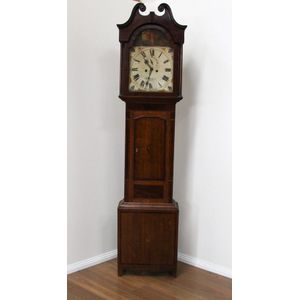English Long Case Clock with Jas Roberts Movement
You must be a subscriber, and be logged in to view price and dealer details.
Subscribe Now to view actual auction price for this item
When you subscribe, you have the option of setting the currency in which to display prices to $Au, $US, $NZ or Stg.
- Ebony - Ebony is a close grained timber, black in colour. It has a fine texture which can be polished to a high gloss, making it suitable for venereering, inlay and stringing and its use as solid timber is resticted to small decorative items and ornamental decoration, such as chess pieces and musical instrument parts. The term "ebonised" means "faux ebony", timber that has been darkened during the polishing process to resemble ebony.
- Movement - The technical name for the workings of a clock or watch, and does not include the dial or case.
- Mahogany - Mahogany is a dense, close grained red-coloured timber from the West Indies and Central America. It was first imported into Europe in the the early 18th century and its use continued through the 19th century. It was popular for furniture making because of its strength, the wide boards available, the distinctive grain on some boards, termed flame mahogany and the rich warm colour of the timber when it was polished.. The "flame" was produced where a limb grew out from the trunk of the tree, and this timber was usually sliced into veneers for feature panels on doors, backs and cornices.
Some terms used to describe mahogany relate to the country from which it originally came, such as "Cuban" mahogany, "Honduras" mahogany etc. However unless the wood has been tested the names assigned are more a selling feature, rather than a true indication of the timber's origin. - Calendar Aperture - A calendar aperture on a clock refers to a small window on the clock face that displays the day, month or year or all of these. The aperture is usually located on the clock's dial with the date data recorded on a wheel which is designed to rotate to show the correct date information.Some clocks have a manual adjustment for the date, while others are designed to automatically adjust for the date, including for leap years. The calendar aperture is a useful feature found on clocks from the 16th century, and on many types of clocks, including wall clocks, alarm clocks and wristwatches.
- Date Aperture - A date aperture is a cut out section in the face of a watch or clock, displaying the day of the month.
This item has been included into following indexes:
Visually similar items

George III mahogany long case clock, the broken arch bonnet enclosing a hand painted dial with Arabic numerals, subsidiary dials for seconds and date, signed 'Baker Dunster', the arch with aperture for rocking sailing ship, single panelled door, two brass

An 18th century long-case clock; two-train movement, silvered Roman numeral dial, maker James Nelson, Banbrudge. Height 205 cm

A Georgian oak and mahogany cased arch brass dial and painted panel grandfather clock. Maker: John Laurence of Lancaster. 231 cm high, 50 cm wide, 25 cm deep.

A fine George III oak longcase 'Cottage clock', circa 1750-80, by Henry Fisher of Preston, with 30 hour single weight movement, the clock with an extended cornice and mahogany cross banded frieze supported by two slender pillars, the brass and silvered dia
